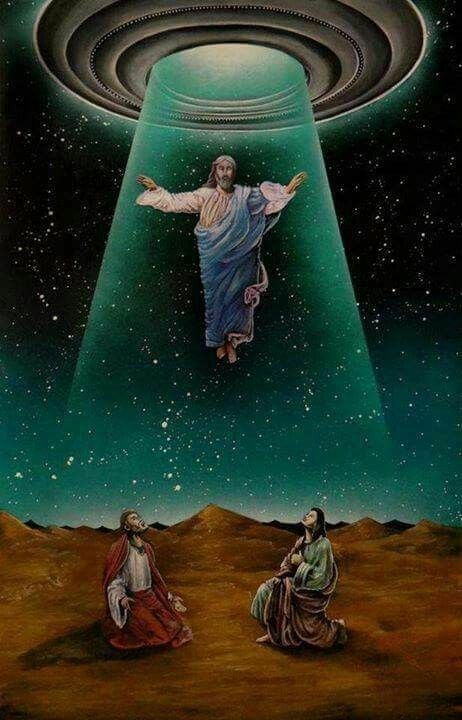“The Holy Bible contains some of the oldest UFO sightings on record.” Or so says the Aetherius Society. Perhaps the most famous, they suggest, is the Star of Bethlehem. What evidence is there for such a conclusion? Well, basically, not much.
It is staggering to think that for centuries it was believed that a star had led the three wise men to a stable in Bethlehem. If a star were to come near enough to this planet, assuming that gravity allowed it to do so in the first place, and then pinpointed a country, never mind a city, never mind a young child in a stable in an inn, there would be a dire cosmic catastrophe. All the laws of science prove that stars cannot possibly do that. No, this was a classic example of a UFO leading three advanced men to a great Interplanetary Master who had been born on this Planet to perform a specific mission.
So there’s no actual biblical textual evidence that the Star of Bethlehem was a UFO. The Greek word translated “star” in the text is the word aster, which is the normal word for a star or celestial body. The word is used 24 times in the New Testament, and most of the time it refers to a celestial body. It is quite possible that the word was used to describe some other celestial event, like a supernova or a comet. But an actual aeriform craft is not intimated. Perhaps the closest this story comes to insinuating a UFO is when the Star is described as “going before” the wise men, “till it came and stood over where the young child was” (Matt. 2:9). However, there’s no suggestion that it was a vehicle or an aerial object. It is not described as being in flight, hovering, or whisking away shepherds or mutilating sheep. So why should we conclude that the Star of Bethlehem was a UFO? Why not consider it a miracle, or some other celestial event (like many others recorded in Scripture)?
Such interpretive leaps are par for the course for biblical UFOlogists.
Yes, “biblical UFOlogy” is a thing. Some have described it in terms of exo-theology — a theology of extraterrestrial life. Books and articles claiming to decipher biblical mysteries in light of alien possibilities are now exceedingly popular. (I’m lookin’ at you, History Channel.) Numerous biblical events are cited as “evidence” of ancient aliens. (You can find a long list of alleged UFO sightings in Scripture HERE.) The pillar of cloud that led the Children of Israel through the desert? (Ex. 13:21) It was a UFO. The whirlwind that God spoke to Job out of? (Job 38:1) It was a UFO. Jesus returning “in the clouds of heaven”? (Mt. 24:30). It’s a fleet of UFOs! Even Moses speaking face to face with God can be interpreted via Hynek’s Scale, as the original Close Encounter of the Third Kind.
Sadly, true theological rigor is often lacking in such interpretations.
The eagerness to baptize one’s UFO devotion with biblical events, people, and texts usually results in all sorts of hermeneutical leaps. Like this guy who’s concluded that “Jesus was a genetically-engineered human-alien hybrid sent to Earth to teach the primitive Humans a lesson of love and tolerance.” After all, He said that He was “not of this world” (Jn. 17:16), right? Then there’s the notion that the Ark of the Covenant was designed by space aliens to be a large capacitor which produced manna in the wilderness. What biblical evidence is there for such a conclusion? Well, Exodus 25 – 26 describe the Ark as an ancient “nuclear reactor,” that required “protective clothing” for those who serviced it (the priestly garments), and regular maintenance (once a year the Ark required “cleaning” and “lubrication,” which occurred on the Day of atonement).
So according to the hermeneutics of biblical UFOlogy, the Day of Atonement was a time for the chosen “technicians” (Moses and Aaron) to clean and lubricate the Ark / Manna Maker / nuclear reactor and keep it operating up to spec.
The eagerness to baptize one’s UFO devotion with biblical texts usually results in all sorts of bad hermeneutics.
Recently, I stumbled upon one UFOlogist’s view of Easter. These excerpts from Barry H. Downing’s “The Bible and Flying Saucers” are a good example of the great leaps one must make to support a hermeneutic of biblical UFOlogy. Downing is a Presbyterian minister and ancient astronaut proponent. He writes,

“All four Gospels suggest that there were unusual persons – beings from another world – present at the empty tomb on Easter morning to explain to the individuals who came to the tomb what had happened. We have seen that at the Transfiguration Jesus was making plans concerning the Crucifixion – Resurrection event with persons from another world (Moses and Elijah) who seemed to have arrived by means of a ‘bright cloud’ type UFO.“There was an ‘earthquake’ associated with the arrival of the angels at the tomb, which could indicate the presence of a UFO which might by its anti-G beam cause a disturbance similar to the one reported at Mount Sinai and the one reported by Elijah outside the cave in which he was hiding.
“What distinguished the angel at the empty tomb was his ‘brightness,’ a property exhibited by the body of Jesus at the Transfiguration. The angel was different from ordinary men not because he had wings, but because ‘his raiment’ was ‘white as snow.’ He wore unusual clothing, perhaps much as our astronauts seem always to wear white clothing to reflect certain types of radiation.”
As someone who is interested in both the Bible and UFOlogy, these kinds of interpretative contortions are revealing. Such conclusions not only suggest a poor reading of Scripture but the super-imposition of a worldview atop it. So rather than taking the Bible at face value, the biblical UFOlogist often deciphers Scriptural phenomenon and events through the lens of a forced exo-theology. Instead of simply interpreting the “bright cloud” that Moses and Elijah appeared in as, well, a bright cloud, the author frames it as a UFO. The “earthquake” that rocked the tomb at Jesus Resurrection can’t just be an earthquake. Instead, it’s a spacecraft’s “anti-G beam.” And the clothing that the angel wore isn’t just radiant, it’s designed to “reflect certain types of radiation.”
Sadly, these kinds of logical stretches are characteristic of much biblical UFOlogy.
Rather than taking the Bible at face value, the biblical UFOlogist often deciphers Scriptural phenomenon and events through the lens of a forced exo-theology.
In 30 Bible Verses about Aliens, the authors reveal a similar proof-texting over-reach. For example, the two following verses are used as evidence that the Bible mentions extraterrestrials.
For our struggle is not against flesh and blood, but against the rulers, against the authorities, against the powers of this dark world and against the spiritual forces of evil in the heavenly realms. (Eph. 6:12)
and
For in him all things were created: things in heaven and on earth, visible and invisible, whether thrones or powers or rulers or authorities; all things have been created through him and for him. (Col. 1:9)
The New Testament asserts that our observed reality is merely a subset of a larger one… a vast world of “visible and invisible” “powers,” all wrestling with mankind and God for spiritual dominance. Might some of these “rulers” and “authorities” be space aliens, extra-terrestrials, or some form of non-human intelligence? Absolutely However, in the context, the apostle Paul is more directly speaking of “spiritual forces of evil” (Eph. 6:12) — demonic entities who are not “flesh and blood.”

In this sense, conflating demons and evil spiritual entities with evidence for space aliens is a tricky proposition. For one, many proponents of biblical UFOlogy tend to view aliens as “allies.” The friendly, peaceful, advanced alien archetype is ubiquitous. However, if we are going to use the aforementioned verses as “proof-texts” that the Bible reveals benevolent alien intelligences, we must admit that such verses are also warnings against spiritual interlopers. In this sense, Ephesians 6:12 is as much a caution against uncritically receiving spiritual, non-human intelligences as it is an affirmation of a cosmos teeming with them.
And that’s the second point I’d like to make here: Framing the cosmos as a multi-dimensional structure is biblical. In other words, our reality consists of both the “visible and invisible” (Col. 1:9). The reason why this is so important is the shift in UFO research. Whereas UFO researchers once interpreted anomalous events simply in terms of physical phenomenon, many are now acknowledging spiritual, mystic, psychic, and metaphysical components. The distinction between ETH and IDH is indicative of this. Whereas UFO researchers used to adhere to ETH — Extra-Terrestrial Hypotheses — they now appeal to IDH — Inter-Dimensional Hypotheses. Jacques Vallee, one of the earlier researchers into the UFO phenomenon concluded, “I believe that the UFO phenomenon represents evidence for other dimensions beyond spacetime; the UFOs may not come from ordinary space, but from a multiverse which is all around us” (Dimensions: A Casebook of Alien Contact). Whatever Vallee’s spiritual outlook on life is, the inference that alien contact may be an interface with beings from another, non-physical dimension is biblically tenable.
UFOs and associated contact with “other” intelligences should indeed be of interest to Christians. Nevertheless, we must not be so enamored of “biblical UFOlogy” that we become guilty of hermeneutical over-reach. Yes, the Bible frames a cosmos teeming with life — both “visible and invisible.” But some of that life is hostile to God’s purposes and Man’s well-being; it is deceptive and crafty and seeking empowerment through human ignorance or acquiescence. A hermeneutic that interprets all contact with inter-dimensional intelligences as beneficent is as bad as one that dismisses all such phenomenon as fake.
Synthesizing UFOlogy and Scripture is tenuous, at best. Does the Bible contain possible evidence of strange aerial phenomenon? Absolutely. Does Scripture describe unusual beings, fantastical events, and celestial wonders. Of course. But interpreting all such phenomenon through an exo-theological lens usually results in bad Bible interpretation. For once one commits to a worldview populated by ancient astronauts, flying saucers, or enlightened ETs, the temptation is to force that perspective into our Bible reading… no matter how awkward it is.
Bottom line: Seeing a UFO in every “burning bush” is just bad theology.
















Biblical UFOlogists suffer from a weird epistemic malady: they have worldview assumptions based in the material world that also aren’t readily falsifiable. Alien/interdimensional spaceships are “viral” like that, since they presumably exist, at least partially, in our material world, they should be falsifiable and demonstrable, but the evidence doesn’t present itself outside of a localized experienced. We’re basically left with forensic evidence, which isn’t enough to satisfy the criteria of most people.
Another thing to note is the nature of UFOs in general. To the ancient Hebrew man, those objects were identified “enough” for them, as the objects were part of the supernatural realm that imposed itself into their experience, which may have expressed itself physically as a spaceship of some kind. Whether or not it was, is irrelevant, since the supernatural aspect was all that the Hebrew man would care about.